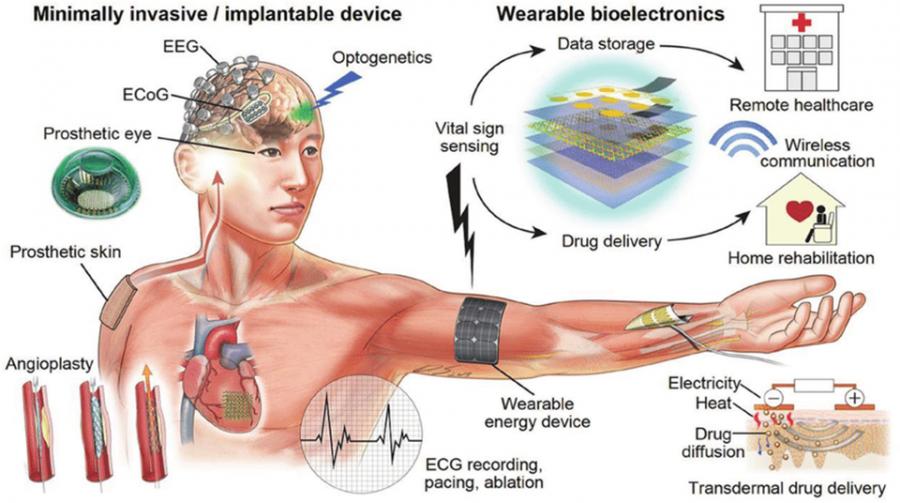 Are you in the final year of your BSc EE studies and interested in electronic medical devices? Then you may wish to consider continuing your studies in the MSc EE profile Biomedical Devices at Technische Universiteit Delft.
Biomedical devices are devices for medical diagnosis, monitoring, and treatment. They can be fixed, portable, wearable, implantable, and injectable. They are active and thus embed #electronics, computing, and software. Examples are: Magnetic Resonance Imaging (#MRI), Computed Tomography (CT), Positron Emission Tomography (#PET), #Ultrasound (US) imaging; Monitors for pulse oximetry, blood pressure, glucose, electrocardiography (#ECG), electro-encephalography (#EEG), electro-myography (EMG), electro-corticography (#ECoG), temperature, galvanic skin response, bio-impedance; Smart watches, smart patches, smart textiles, smart catheters, smart implants; Cardiac assist devices, cardiac pacemakers, implantable cardiac defibrillators (ICD); Devices for transcranial magnetic stimulation (TMS), transcutaneous electrical nerve stimulation (TENS), focussed ultrasound stimulation (FUS); Neurostimulators, brain-machine interfaces, organs-on-chip devices, #bioelectronicmedicine, #electroceuticals.
The Biomedical Devices profile has three focus areas = sub-profiles: 1. Biosensors, BioMEMS and Microsystem Integration (BioSemi), part of the EE track Microelectronics; 2. Biomedical Circuits and Systems (BioCAS), part of the EE track Microelectronics; 3. Biomedical Signal Processing (BioSP), part of the EE track Signals and SystemsFor registration, see: https://www.tudelft.nl/onderwijs/opleidingen/masters/ee/msc-electrical-engineering/biomedical-devices-bd-profile
We look forward to welcoming you to Delft!
Are you in the final year of your BSc EE studies and interested in electronic medical devices? Then you may wish to consider continuing your studies in the MSc EE profile Biomedical Devices at Technische Universiteit Delft.
Biomedical devices are devices for medical diagnosis, monitoring, and treatment. They can be fixed, portable, wearable, implantable, and injectable. They are active and thus embed #electronics, computing, and software. Examples are: Magnetic Resonance Imaging (#MRI), Computed Tomography (CT), Positron Emission Tomography (#PET), #Ultrasound (US) imaging; Monitors for pulse oximetry, blood pressure, glucose, electrocardiography (#ECG), electro-encephalography (#EEG), electro-myography (EMG), electro-corticography (#ECoG), temperature, galvanic skin response, bio-impedance; Smart watches, smart patches, smart textiles, smart catheters, smart implants; Cardiac assist devices, cardiac pacemakers, implantable cardiac defibrillators (ICD); Devices for transcranial magnetic stimulation (TMS), transcutaneous electrical nerve stimulation (TENS), focussed ultrasound stimulation (FUS); Neurostimulators, brain-machine interfaces, organs-on-chip devices, #bioelectronicmedicine, #electroceuticals.
The Biomedical Devices profile has three focus areas = sub-profiles: 1. Biosensors, BioMEMS and Microsystem Integration (BioSemi), part of the EE track Microelectronics; 2. Biomedical Circuits and Systems (BioCAS), part of the EE track Microelectronics; 3. Biomedical Signal Processing (BioSP), part of the EE track Signals and SystemsFor registration, see: https://www.tudelft.nl/onderwijs/opleidingen/masters/ee/msc-electrical-engineering/biomedical-devices-bd-profile
We look forward to welcoming you to Delft!
About the Bioelectronics blog
In this weblog you can find the latest information on ongoing activities in and contributions by the Section Bioelectronics of Delft University of Technology. In this group we are working on Biosensors, Organs on Chip, Flexible Implants, Artificial Retinas, Spinal-Cord Implants, Medical Body-Area Networks, Energy Harvesting, Neurosensing Devices, Neurostimulators, Electroceuticals and Bioelectronic Medicines
-
Recent Posts
Categories
- Bioelectronic Medicine (9)
- Brain-Machine Interfaces (32)
- Education (60)
- Electronics (56)
- Energy Harvesting (16)
- General (253)
- Implantables (9)
- Medical Body Area Networks (15)
- Music (5)
- Neonatology (9)
- Neurostimulation and Neuromodulation (71)
- Pacemakers (16)
- Technology for Neuroscience (1)
- Understanding the Brain (67)
- Wearables (3)
Archive
Meta
Disclaimer
De meningen ge-uit door medewerkers en studenten van de TU Delft en de commentaren die zijn gegeven reflecteren niet perse de mening(en) van de TU Delft. De TU Delft is dan ook niet verantwoordelijk voor de inhoud van hetgeen op de TU Delft weblogs zichtbaar is. Wel vindt de TU Delft het belangrijk - en ook waarde toevoegend - dat medewerkers en studenten op deze, door de TU Delft gefaciliteerde, omgeving hun mening kunnen geven.
